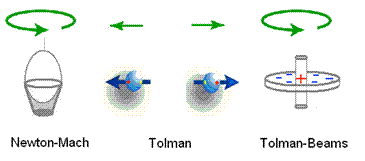Gravity, Quantum Objects, and Violations of the Equivalence Principle
How do quantum objects respond to gravity? It seems a simple enough question and yet one that leaves theorists scratching their heads. And so it should. The analysis to date implies that quantum objects violate the fundamental idea that gravitational and inertial mass are the same thing, an idea known as the equivalence principle.

Here’s the thinking as laid out today by Timir Datta at the University of South Carolina and buddy Ming Yin: In the second decade of the 20th century, a group at Caltech began to puzzle over the inertial properties of electrons in conductors. They argued that the trailing end of an accelerating metal rod would be negatively charged because the electrons would lag behind the conducting lattice as it sped up. Likewise, they surmised that the circumference of a rotating disk would also be negatively charged with electrons flung into the periphery.
By this analysis, the effect of a linear or radial acceleration on a quantum fluid is the same as it is on a Newtonian fluid, like water in a spinning bucket. Richard Tolman and others even claimed to have measured this buildup of charge.
But according to the equivalence principle, if an acceleration can have this effect on electrons, so too can a gravitational field.
Here things get a little more complex. Calculating the equilibrium that occurs when gravity acts on a solid crystal filled with conducting electrons is no easy task.
It turns out that if the crystal is rigid, then gravity pulls the electrons downward, creating a tiny buildup of negative charge at the bottom of the crystal and a small electric field that points down. That’s exactly as the equivalence principle implies.
If the crystal is deformable, however, gravity has a larger effect on the lattice than it does on the electrons. In this case, gravity compresses the lattice, creating a positive charge density toward the bottom of the conductor. Now the electric field is several orders of magnitude bigger and points in the opposite direction.
That’s a troubling result because it means that it ought to be possible to tell the difference between an inertial acceleration and a gravitational one by measuring the direction of the electric field that builds up. And according to general relativity, that ain’t possible. Surely general relativity, one of the cornerstones of modern physics cannot be wrong on this point. So what’s gone wrong?
One obvious question that is unanswered (at least by Datta and Yin) is why an inertial acceleration does not compress the crystal lattice in the same way as a gravitational field, creating the same kind of positive charge density.
The measurements made by Tolman and others suggest that this kind of compression does not occur.
Unless the measurements are wrong. Could it be that this conundrum arises only because of a few erroneous measurements?
If so, perhaps it’s time for somebody to try them again.
Ref: arxiv.org/abs/0908.3885: Do Quantum Systems Break The Equivalence Principle?
Keep Reading
Most Popular
Large language models can do jaw-dropping things. But nobody knows exactly why.
And that's a problem. Figuring it out is one of the biggest scientific puzzles of our time and a crucial step towards controlling more powerful future models.
How scientists traced a mysterious covid case back to six toilets
When wastewater surveillance turns into a hunt for a single infected individual, the ethics get tricky.
The problem with plug-in hybrids? Their drivers.
Plug-in hybrids are often sold as a transition to EVs, but new data from Europe shows we’re still underestimating the emissions they produce.
Stay connected
Get the latest updates from
MIT Technology Review
Discover special offers, top stories, upcoming events, and more.